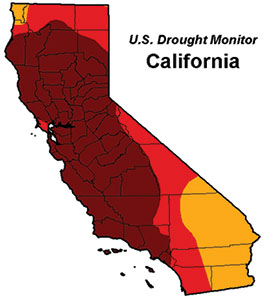Google defines a drought as ďa prolonged period of abnormally low rainfall; a shortage of water resulting from this.Ē

Published: January, 2015
Google defines a drought as “a prolonged period of abnormally low rainfall; a shortage of water resulting from this.”
California is going on four years since its latest drought began. It got so bad that in January 2013, Governor Brown officially declared us to be in a state of emergency and asked residents to help out by reducing their water usage. It took time for Californians to respond to the challenge, but in the end many people stepped up; cars were left unwashed, toilets unflushed and plants unwatered.
Then came December 2014. We got hit with a few big storms, and with it, some much-needed rain. But here’s the kicker—we’re not in the clear just yet. Even with the recent bout of rain, we still need a lot more of it to make up for three years of below average rainfall.
What this means is that you shouldn’t stop conserving your water just yet. Every little bit continues to help. In fact, if you’re in need of a little inspiration or a few new ideas for how you can conserve water, we’ve got some useful facts and tips to help you get started:
• In recent years, the average residential water use in California has been 105 gallons per person per day. In contrast, average individual residential use in Australia is about 56 gallons each day. Imagine what cutting our residential use in half would do to create a more reliable water supply and protect the environment.
• It takes 1,115 gallons of water to produce one pound of sunflower and safflower oil, and 1,775 gallons to produce a pound of beef. In contrast, it only takes 11 gallons to produce a pound of frozen mixed vegetables, carrots or celery. Agricultural water use consumes 80 percent of California’s developed water supplies. Using this finite supply to grow water-intensive crops in a drought-prone, semi-arid environment is wasteful—and not sustainable in the long term.
• Water losses due to leaks in utility distribution systems before water even gets to your water meter add up to nearly one million acre-feet in California each year, equivalent to about 21 gallons per capita per day. Leaks between your water meter and your house average seven to 10 gallons per capita per day.
What you can do to save water:
• Cut down on water use in and around your home. Check for leaks, install water efficient toilets, clothes washers and other appliances, and design your yard or garden to require little or no water. The best way to start conserving is to visit the California Urban Water Conservation Council’s comprehensive website at www.h2ouse.org, and take a virtual tour around the house and yard to get specific information and advice about the most water-efficient actions you can take.
• Be a pioneer and start reusing water. The State of California and some local governments and water districts are making it easier to use graywater—water from sinks, showers and washing machines—for landscape irrigation, and in new developments for flushing your toilet.
• Support the Bay Institute’s efforts to promote dozens of actions that federal, state and local agencies can take to increase water supplies from drought-resistant sources such as water efficiency, water recycling and stormwater management; expand environmentally friendly and economically efficient water storage capacity; and use investments in natural infrastructure and healthy ecosystems to drought-proof the water supply. The Bay Institute’s new drought action plan identifies the potential to develop millions of acre-feet of new water for Californians from water conservation, groundwater banking, urban runoff and other sources—without building harmful and expensive new dams and diversions.
Find out more about the drought action plan, plus more tips to conserve water at www.thebayinstitute.org.
This article was provided to Bay Crossings by the Bay Institute.

